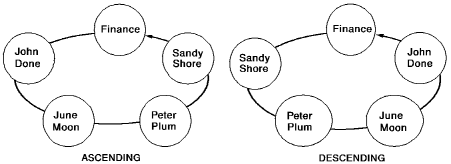

You can specify the logical order of child occurrences within each linked relationship:
For example, all new entity occurrences might be positioned ahead of all existing occurrences.
Advantages of a sorted relationship
Through a sorted relationship:
Considerations for sorted relationships
Maintaining the relationship's order during update operations requires increased CPU and a greater number of I/Os than an unsorted relationship.
Enforcing unique constraints
Sorted relationships can be used to enforce unique constraints as an alternative to a CALC key or index. For example, you can eliminate the EXP-NDX index in the Commonweather Corporation by defining either the SKILL-EXPERTISE or the EMP-EXPERTISE relationship as a unique sorted relationship.

To eliminate the index, you must either:
or
Either approach ensures that no employee is assigned duplicate skills.
Sorted order
You can choose to sort in ascending, descending, or mixed order.
As a general rule, choose the sort order to reflect the most commonly desired retrieval order. However, the sequence chosen for a chained relationship can have an impact on performance in update transactions. This will allow the DBMS to locate the point of insertion more quickly.
If new entity occurrences typically have sort key values greater than existing occurrences, the relationship should have a descending sort order. Conversely, if new occurrences have sort keys lower than existing occurrences, ascending is preferable.
For example, new occurrences of dated entities are usually stored with higher dates than previously stored occurrences. If this is the case, you should specify descending for a chained relationship sorted by date.
More Information
For more information concerning the usage of numeric fields as part of a sort key, see Zoned and Packed Decimal Fields as IDMS Keys.

|
Copyright © 2014 CA.
All rights reserved.
|
|